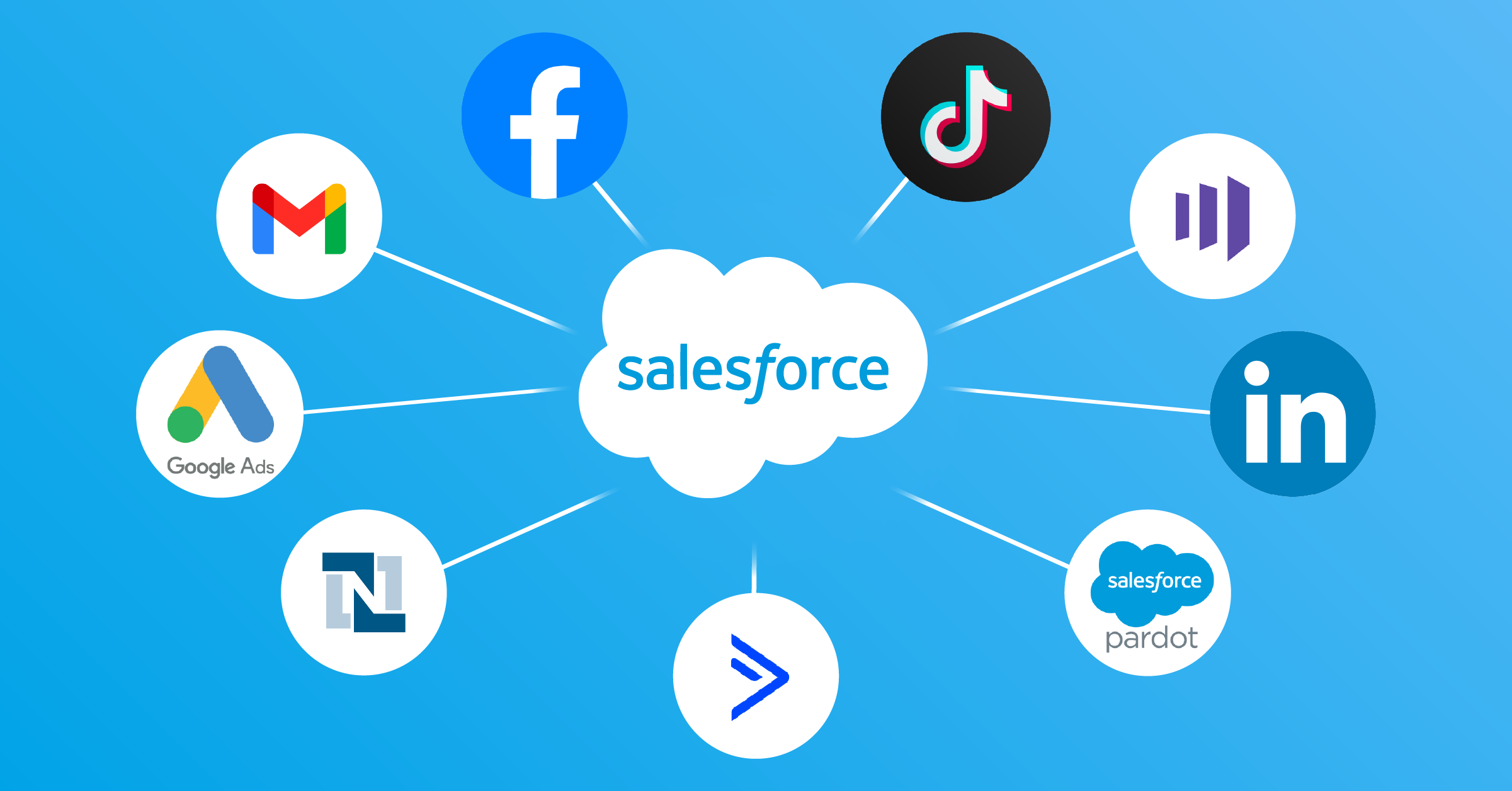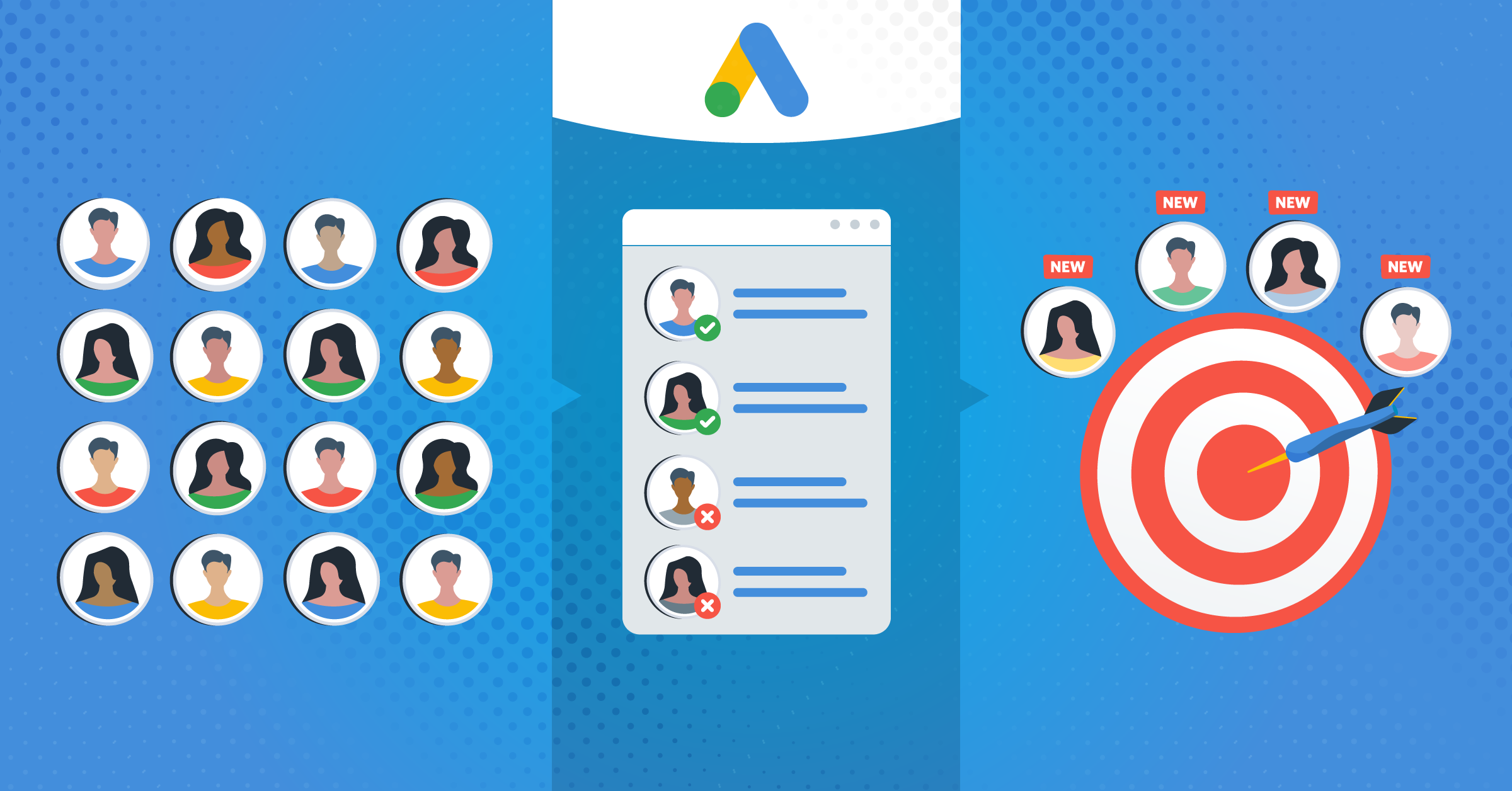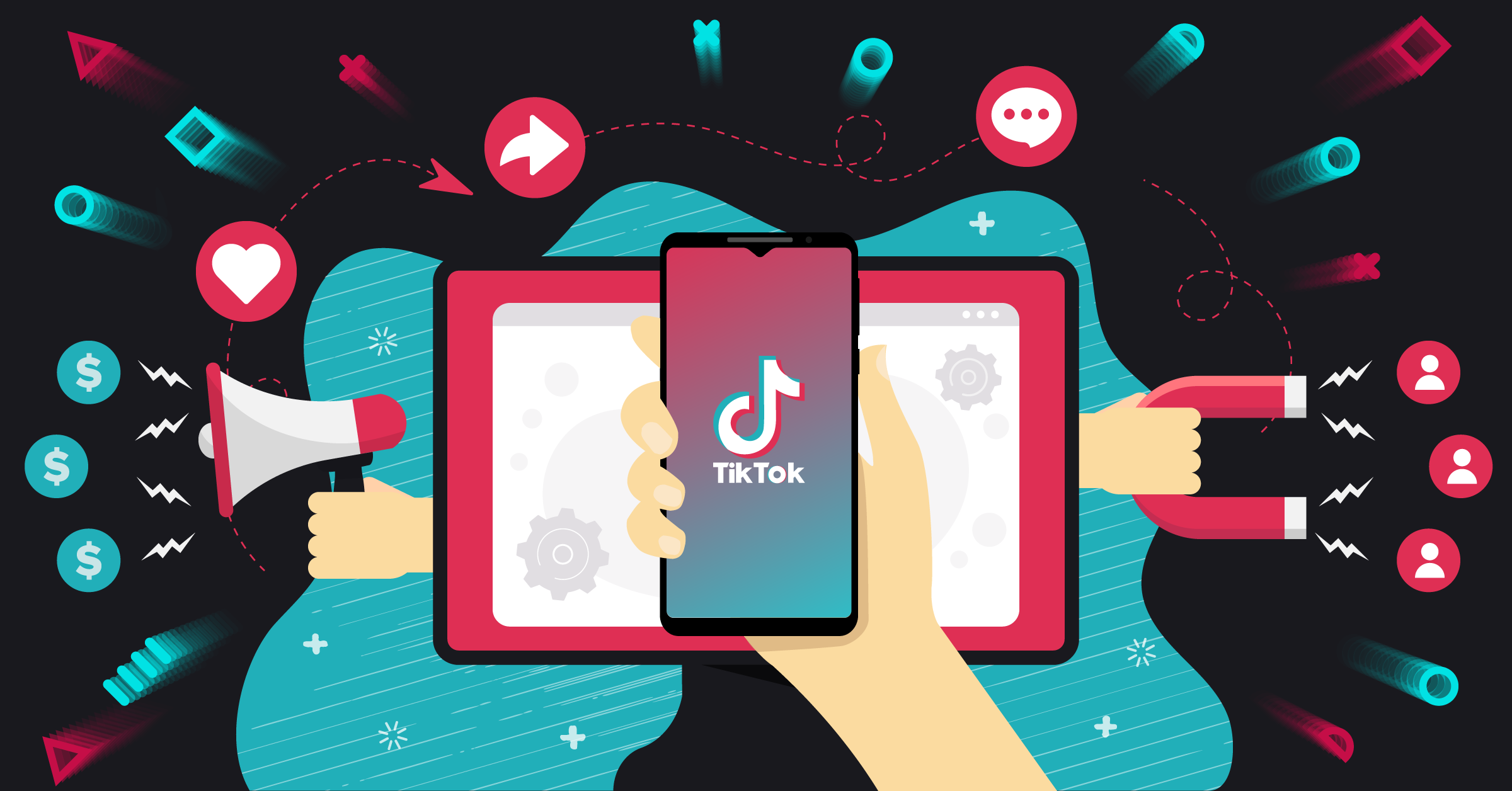
Salesforce® is one of the most popular sales forecasting and CRM tools on the market today for small businesses and enterprise-size companies alike. They can help you track every customer interaction and nurture leads. Also, they help get a better understanding of what’s driving sales so you can optimize your pipeline moving forward.
Speaking of the wonders of CRMs, Salesforce® has a number of incredible features on its own. However, connecting it to the rest of your marketing stack can really help up your game and increase the value you get from the tool. That’s why we’re going to look at the best Salesforce® integrations for 2024 so you can get the most out of the platform.
- What are integrations in Salesforce® & why do they matter?
- What are Salesforce® integration tools?
- Benefits of using Salesforce® integration software
- Best Salesforce® integrations for 2024
- MailChimp Salesforce® integration
- Salesforce® Gmail integration
- NetSuite Salesforce® integration
- Marketo Salesforce® integration
- ActiveCampaign Salesforce® integration
- Pardot Salesforce® integration
- Facebook Salesforce® integrations
- Salesforce® Google Ads integrations
- Salesforce® LinkedIn integrations
- Salesforce® TikTok integration
- Final thoughts
What are integrations in Salesforce® & why do they matter?
Salesforce® can do an awful lot on its own. This includes extensive features that you don’t often find with many other platforms. For instance, there’s the Salesforce® Marketing Cloud to manage and automate marketing workflows.
Integrations can make tools more useful. However, it can offer new capabilities if it has access to more data. This means more features and also more automation depending on the integrations that you choose.
Business automation is a key factor here. It allows you to streamline your processes and ensure that nothing is missed while delivering results with more immediacy. As soon as users submit lead forms, for example, you want them delivered straight to your sales team. This ensures swift marketing software action can be taken. Either way, you don’t want to wait a day or more to manually transfer that data.
Salesforce® 3rd party integrations let you share data and trigger actions between its CRM platform and other tools that you’re already using. You can have new leads added to segmented email lists or have new lead information from Facebook Ads go straight to Salesforce®.
With the right Salesforce® automation tools, your team can put their energy where it’s needed. That is, instead of trying to maintain outdated data or chase down data that could just appear in front of them.
What are Salesforce® integration tools?
Salesforce® integration tools are third-party services that make it easier to set up a number of integrations. These include some custom integrations you may not find on the two brands’ sites. LeadsBridge is designed to help you connect the SaaS tools that you’re already working with, including Salesforce®.
We can streamline the integration process using automated data bridges. This lets you access additional possibilities for automation thanks to triggered actions and results that may not have been available without our services.
Installation takes just a few clicks, and then you can customize the integration as you see fit. We can even help you create custom-triggered actions and results if you can’t find an integration that offers exactly what you’re looking for.
Fortunately, these Salesforce® integration tools are exceptionally easy to set up.
Benefits of using Salesforce® integration software
There’s no doubt that Salesforce’s native integrations provide a solid medium to connect the platform with a variety of marketing or sales apps. But they do not cover all the specific needs or niche tools a business uses. That’s where LeadsBridge fills this gap. LeadsBridge’s Salesforce® integration software offers:
- Extensive integration options: LeadsBridge provides access to a wider array of integrations with platforms that might not be natively supported by Salesforce. This lets you connect Salesforce® with your favorite marketing tools, ecommerce platforms, or even custom-built apps.
- Better customization: LeadsBridge’s customization options are plenty. This includes detailed data mapping and synchronization rules, that you can tailor to meet specific business needs and workflows. This level of customization is not available with Salesforce®’s native integrations.
- Higher data accuracy: Having all your data stack connected means better data hygiene and broader accessibility. LeadsBrdige offers a ton of integrations to help you build a centralized and interconnected data hub, while Salesforce® integrations connect you from the platform to (any) point B.
- Responding to your business’s evolving needs: Your business is bound to grow and so your needs change. The flexibility that LeadsBridge’s extensive integration offers helps you quickly adapt your tech stack. This adaptability also means that you can leverage your Salesforce investment more effectively over time (and without being limited by the scope of native integrations).
Then there are Salesforce®’s native integrations. While these are some robust automation tools, they have some limitations:
- Limited coverage: Salesforce®’s built-in options might not cover all the specific tools and applications you use as a business.
- Less customization: The customization options for data handling and workflow automation are more limited. This means that you have to compromise on how data is managed and used.
- Dependency on Salesforce®’s roadmap: If you are using Salesforce®’s native integrations, you are also dependent on their development roadmap for new features and integrations. This is not a great strategy to respond to your business’s immediate or unique needs.
Best Salesforce® integrations for 2024
There are plenty of Salesforce® integrations that you can choose from on their site, and there are even more available through LeadsBridge. Let’s take a look at some of the best Salesforce® integrations available in 2024.
MailChimp Salesforce® integration
Email marketing tools and your CRM tools are at their most effective when fully integrated. This makes the MailChimp and Salesforce® email integration particularly important.
You can create new email subscribers as contacts or add them to lists in Salesforce®. Or organize your MailChimp subscribers into Salesforce® groups based on activity. This is an easy way to keep two core data sources connected while providing your sales team with vital information about the customer journey on an automated basis.
See how to connect Salesforce® with Mailchimp.
Salesforce® Gmail integration
While many businesses do use company email addresses, many more use individual Gmail accounts. If you are a freelancer or own a small business, for instance, you may use a Gmail account for business communications. Then, Salesforce® and Gmail integration can take a workload off you.
With this integration, you can create new leads from Gmail in Salesforce®. Or, update them at any time based on the progression through the digital sales funnel. This sounds simple, but when you’re a small or single-person business, these two features make it much easier to track leads across the board.
You can see how to set up Salesforce® – Gmail integration here.
NetSuite Salesforce® integration
NetSuite is a strong business management software with an Enterprise Resource Planning (ERP) solution. It only makes sense that integrating your business management software with your CRM and sales forecaster could benefit your business.
Our NetSuite and Salesforce® integrations allow you to do the following (and more):
- Create new NetSuite leads with Salesforce® (or create them in saved searches with Salesforce®)
- Create NetSuite employees with Salesforce®
- Update NetSuite prospects with data from Salesforce®
- Update or create NetSuite partners in saved searches with Salesforce®
See how to integrate NetSuite with Salesforce® here.
Marketo Salesforce® integration
Marketo offers strong automation features to help businesses track, identify, and nurture customers and leads. Its lead management software is exceptional, so integrating it with Salesforce®’s CRM can be a powerful combination.
Our Marketo and Salesforce® integration allows you to share lead data between the two platforms so you can create or update leads in static lists on Salesforce®. This gives you more immediate and actionable information that you wouldn’t have had otherwise, giving your team new tools to convert leads faster.
See how to connect Salesforce® and Marketo.
ActiveCampaign Salesforce® integration
ActiveCampaign is another automation-focused tool. It is centered around creating email marketing messaging and autoresponder follow-up sequences to nurture leads and customers. Pairing up the data you pull from ActiveCampaign with the data you have in Salesforce® makes both tools much more actionable.
Our ActiveCampaign Salesforce® integration can do the following:
- Create and update new ActiveCampaign contacts as tags in Salesforce®
- Create and update new ActiveCampaign contacts as lists in Salesforce®
- Create and update new ActiveCampaign contacts as segments in Salesforce®
You’re basically getting updated information about your audience from ActiveCampaign into your CRM on a regular basis. See how to set up ActiveCampaign and Salesforce® integration here.
Pardot Salesforce® integration
Pardot is actually a Salesforce® tool that focuses on automation and email solutions for B2B brands. A Pardot and Salesforce® 3rd party integration, therefore, makes plenty of sense.
Our Pardot and Salesforce® integration offers a number of capabilities including the following:
- Create and update Salesforce® accounts in Pardot
- Create and update Salesforce® accounts as lead sources in Pardot
- Update Salesforce® leads in Pardot reports
- Update Salesforce® person accounts in list views in Pardot
You’re sharing more actionable data back and forth between the two platforms. This helps have a better understanding of what’s happening with your audience while delivering strong marketing messaging in the process. See how to set up our Pardot and Salesforce® integration.
Facebook Salesforce® integrations
So far we’ve looked at specific individual integrations. But we also wanted to look at a list of integrations available for Facebook and Salesforce® with LeadsBridge. We offer individual Salesforce® integrations for multiple Facebook tools, including Facebook Lead Ads, Facebook Conversions API, Facebook Conversion Leads, Facebook Custom Audiences, and more.
These integration options are expansive, and the idea is to give you full control over the tools you use. Then, you have the integrations you need to improve your workflow and nothing else.
You can use the Lead Ads integration to send new lead information captured from on-platform leads straight to Salesforce®. After that, have a Salesforce® and Custom Audiences integration set up so you can add that new lead to a Custom Audience for retargeting on Facebook.
Some of the most useful integrations for most businesses may include:
- Tracking offline conversions from Facebook and sending the data to Salesforce®
- Importing job applicants into Salesforce® after they’re submitted
- Tracking Facebook conversions from their Conversions API and sending it to Salesforce® directly
- Sending lead information from Lead Ads to Salesforce®
- Sending Salesforce® to Facebook Custom Audiences in segmented lists
Salesforce® Google Ads integrations
LeadsBridge is a reliable and efficient platform that offers multiple, powerful Salesforce® Google Ads integrations for businesses looking to streamline their marketing operations. With this integration, you can synchronize your Google Ads campaigns with your Salesforce® lead management system.
This makes it easier to track and analyze your advertising results. This means that you can easily see which leads are coming from your Google Ads campaigns and use this information to improve your overall marketing strategy.
The platform also offers advanced automation features that help you save time and effort. For example, setting custom lead assignment rules, which ensure that each lead is assigned to the right salesperson. The integration with Salesforce® also includes real-time reporting.
This means that you can track your campaign performance in real time and make adjustments as necessary. With LeadsBridge, you can easily set up your Salesforce® Google Ads integration and start reaping the benefits of a streamlined marketing process.
Salesforce® LinkedIn integrations
Salesforce® LinkedIn integration via LeadsBridge can bring a multitude of advantages to B2B brands. When you connect these two powerful platforms, you have better lead generation workflows, account-based marketing campaigns, and stronger engagement with prospects.
LeadsBridge’s integration allows for the automatic syncing of LinkedIn lead form data into Salesforce®. This reduces the chances of data errors and increases efficiency in lead management. Additionally, sales teams can access LinkedIn profile information from within their Salesforce® account, improving their understanding of target accounts and decision-makers.
With LeadsBridge’s Salesforce® 3rd party integration, users can set up quick and easy workflows to automate the flow of data between LinkedIn and Salesforce®. This way, it becomes easier for sales and marketing teams to collaborate.
The bottom line is that Salesforce® LinkedIn integrations through LeadsBridge help businesses streamline their lead generation flows and improve their sales and marketing efforts.
Salesforce® TikTok integration
Integrating Salesforce® with TikTok helps you leverage your digital marketing to its fullest. Using LeadsBridge, you can build integrations that bridge the gap between TikTok’s (uniquely) dynamic advertising platform and Salesforce®’s powerful CRM features.
Salesforce® TikTok integration lets you automatically import the lead data you collect from TikTok lead generation campaigns. And sync them directly into Salesforce®, in order to streamline your lead management.
If you are dealing with an audience, you would want to know which content has gotten the most impressions. Or, which ad campaign had the best conversions. Building the TikTok Conversion API Salesforce® integration via LeadsBridge helps you track and analyze the effectiveness of your TikTok advertising campaigns within Salesforce®. This also enables you to have a deeper understanding of your marketing ROI and customer behavior.
By creating Salesforce® TikTok integration, you can also tailor your marketing strategies to engage with the highly active and in-the-now TikTok audience.
Final thoughts
Automation is a necessity in today’s fast-moving world. You need your sales and customer service teams to have the ability to act on immediate and up-to-date data at all times, whether they’re looking to extend new offers or to follow up with existing leads.
The Salesforce® 3rd party integrations that we’ve discussed above all use automation and strategic streamlining to improve your team’s workflow and the customer experience all at once. This saves you time and money while making it easier for you to convert sales in this always-on-the-move world.
As a reminder, this post only contains a list of our favorite Salesforce® integrations; there are hundreds more integrations available with different tools, so check out the full library of Salesforce® 3rd party integrations we offer to see if other tools you use are on the list.
Want to integrate with Salesforce® and streamline your workflow further? See our full list of Salesforce® integrations here.































